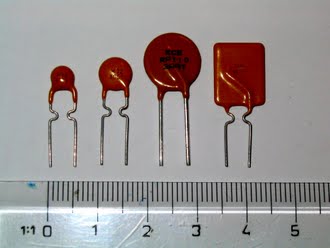You are at: Elements - Sensors - Thermistors
Thermistors are inexpensive, easily-obtainable temperature sensors. They are easy to use and adaptable. Circuits with thermistors can have reasonable outout voltages - not the millivolt outputs thermocouples have. Because of these qualities, thermistors are widely used for simple temperature measurements. They're not used for high temperatures, but in the temperature ranges where they work they are widely used.
Thermistors are temperature sensitive resistors. All resistors vary with temperature, but thermistors are constructed of semiconductor material with a resistivity that is especially sensitive to temperature. However, unlike most other resistive devices, the resistance of a thermistor decreases with increasing temperature. That's due to the properties of the semiconductor material that the thermistor is made from. For some, that may be counterintuitive, but it is correct. Here is a graph of resistance as a function of temperature for a typical thermistor. Notice how the resistance drops from 100 kW, to a very small value in a range around room temperature. Not only is the resistance change in the opposite direction from what you expect, but the magnitude of the percentage resistance change is substantial.
In this lesson you will examine some of the characteristics of thermistors and the circuits they are used in.
| T (oC) | R (W) |
| 16, 330 | |
| 25 | 5000 |
| 50 | 1801 |
Using these values, we can get three equations in A, B and C.
(1/273) = A + B ln(16330) + C (ln(16330))3
(1/298) = A + B ln(5000) + C (ln(5000))3
(1/323) = A + B ln(1801) + C (ln(1801))3
This set of simultaneous linear equations can be solved for A, B and C. Here are the values computed for A, B and C.
A = 0.001284
B = 2.364x 10-4
C = 9.304x 10-8
Using these values you can compute the reciprocal, and therefore the temperature, from a resistance measurement.
Using these values for A, B and C we obtain a plot of resistance vs. Kelvin temperature.
Getting the temperature from resistanceIf you have a resistance value - and that is what you will measure electrically - you then need to solve for the temperature. Use the reciprocal of the equation above, and you will get:
T = 1/[A + B*ln(R) + C*(ln(R))3] R in W, T in oK
However, if the thermistor is embedded in a circuit - like a voltage divider, for example - then you will have to measure electrical quantities - usually voltage - and work back from that electrical measurement.
There will be situations where you need to measure a higher temperature than a thermistor can work in. Or you may need more precision than a thermistor can give. Consider a thermocouple or and integrated circuit sensor like the LM35.How Do You Use A Thermistor?
In this bridge circuit, three resistors are constant, Ra, R, and R, while the resistive sensor, Rs, varies depending upon some physical variable - like temperature, light level, etc. That's where the thermistor can be used.
 A polymeric positive temperature coefficient device (PPTC, commonly known as a resettable fuse, polyfuse or polyswitch) is a passive electronic component used to protect against overcurrent faults in electronic circuits. They are actually non-linear thermistors...
A polymeric positive temperature coefficient device (PPTC, commonly known as a resettable fuse, polyfuse or polyswitch) is a passive electronic component used to protect against overcurrent faults in electronic circuits. They are actually non-linear thermistors...
 A thermostat is a component of a control system which senses the temperature of a system so that the system's temperature is maintained near a desired setpoint. The thermostat does this by switching heating or cooling devices on or off, or regulating the flow of a...
A thermostat is a component of a control system which senses the temperature of a system so that the system's temperature is maintained near a desired setpoint. The thermostat does this by switching heating or cooling devices on or off, or regulating the flow of a...